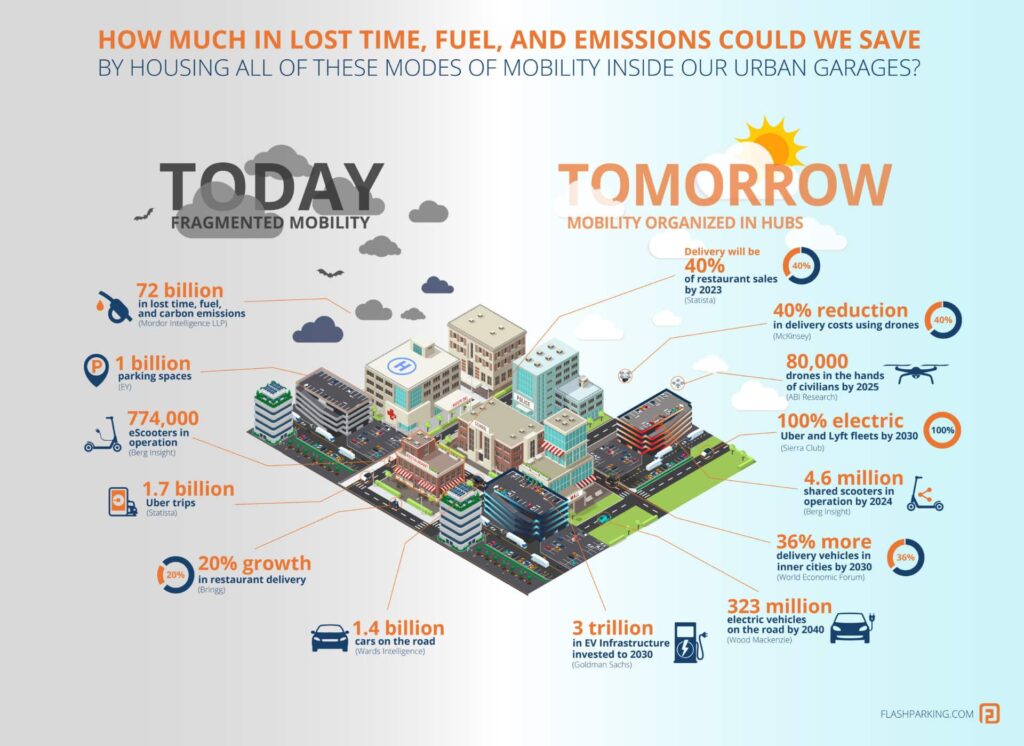Multiplying Modes
More people. More places to go. Some get there by car, others by public transit or foot — and increasingly by bikes and eScooters. But all these ways of getting from A to B struggle to coexist in peace: pedestrians find themselves weaving between discarded eScooter, cars back up behind rideshare drivers picking up passengers, and they’re all competing for valuable curb space that’s often occupied by delivery trucks.
There's a Better Way
All these modes that emerged with a promise to be the fastest, safest, or most efficient way of getting around ultimately end up slowing each other down and pushing emissions higher. There has to be a better way.
To achieve harmony in the new multimodal mobility ecosystem, we have to shift the weight off our streets and sidewalks and into adjacent hubs: someplace where delivery trucks can unload packages, eScooters can park, and Uber drivers can intercept passengers.
The Key to the Smart City
The “where” is hiding in plain sight: parking assets. Already occupying some of the most valuable real estate in urban areas, parking has the centrality and capacity to house all of our mobility devices.
All parking needs to become the key to the smart city is a new mindset and the right technology: a smart parking system that will raise the gate for more than just cars.
The Mobility Hub Model
Mobility hubs aren’t a foreign idea – although they might seem that way at first. We’ve been using mobility hubs for centuries: train stations, airports, and bus stops. These hubs have always been points where many modes of movement intersect. We take cars and taxis to airports and then take off in a plane, we bike to the stop and take off on a bus, or walk to the stations to speed off on a trains. We can use garages in this same way, bringing many modes of mobility to a single point of intersection – all we need is a way to operate them with the efficiency of our airports and train stations.
That’s why we created FlashOS.
FlashOS: The First Mobility Hub Operating System
When we set out to create the world’s first operating system for mobility hubs, we knew it needed three things: parking, because we saw opportunity in underutilized assets in our city cores; intelligence, because it is the foundation of any successful business strategy today; and mobility integrations, because our transportation ecosystem is no longer only made up of cars.
Now, we knew the foundation of access and revenue control was necessary – but the “push a button to get a ticket” model isn’t up to par with the future-ready hubs we want to power. That’s why we designed our entire product lineup with next-generation capabilities (think Bluetooth and mobile payments) plus the ability to adapt endlessly (because we know innovation is never complete).
Next came the intelligence piece. We designed a cutting-edge intelligence portal to give growing mobility hubs the real-time insight they need to make informed decisions about new service offerings and other ways to diversify their revenue structure.
Finally, we did the legwork for asset owners and operators by assembling a network of ready-to-launch integrations in transportation and logistics. Our growing ecosystem of partners acts as a link between parking assets and new consumer markets for services like EV charging, eScooters, and delivery services.
“Is Parking Dead?” Webinar
Parking emerging as the key to the smart city is our answer to the question “Is Parking Dead?”
Parking as we know it is dead; but parking’s new role is just coming to life — and it’s more valuable than ever before.
Neil Golson, our EVP of Marketing hosted a webinar to explain the new landscape and why parking plays vital role. You can watch the webinar on demand to discover how you can be one of the parking assets that retains relevance as other fall into obsolescence.


